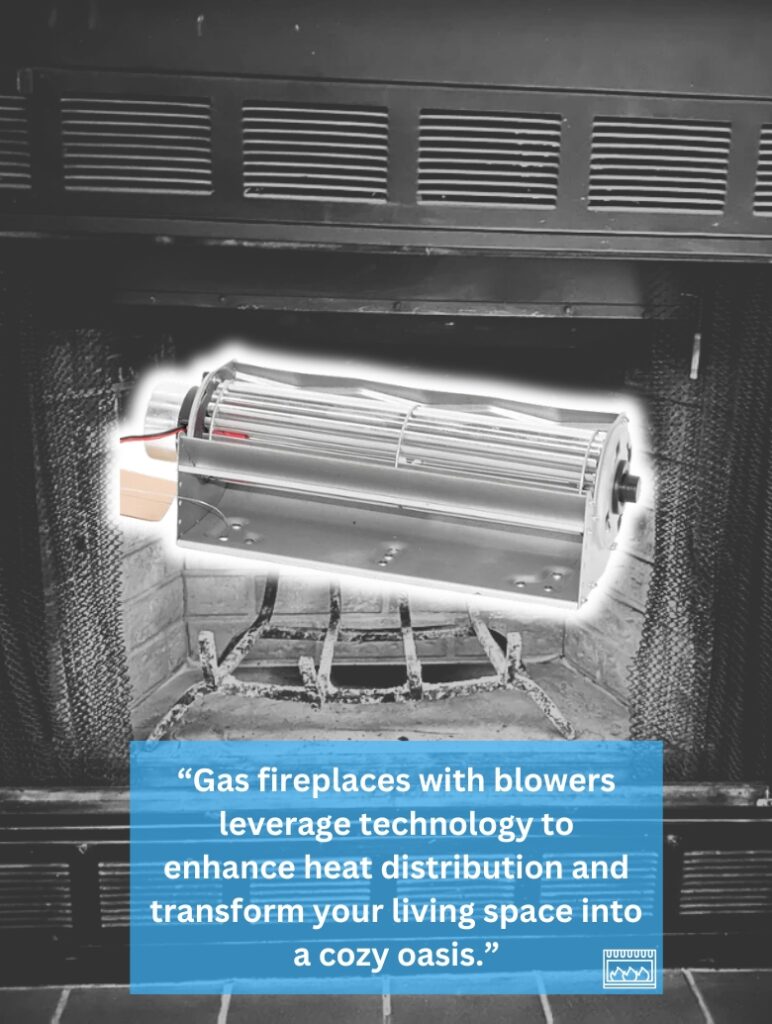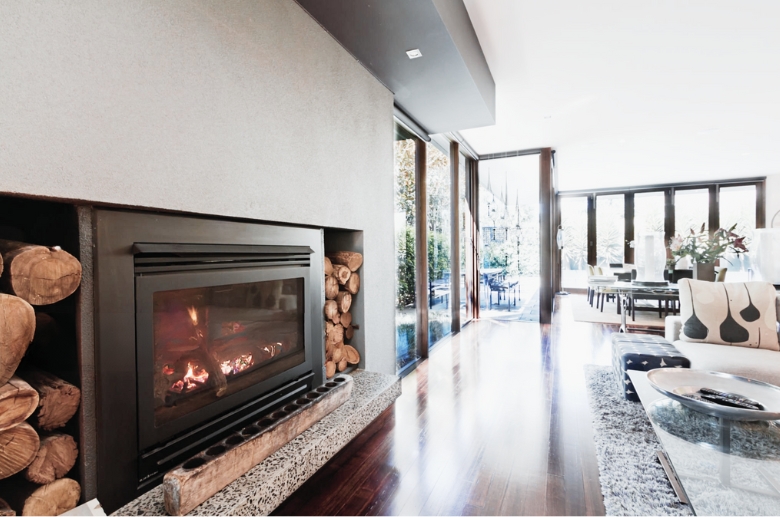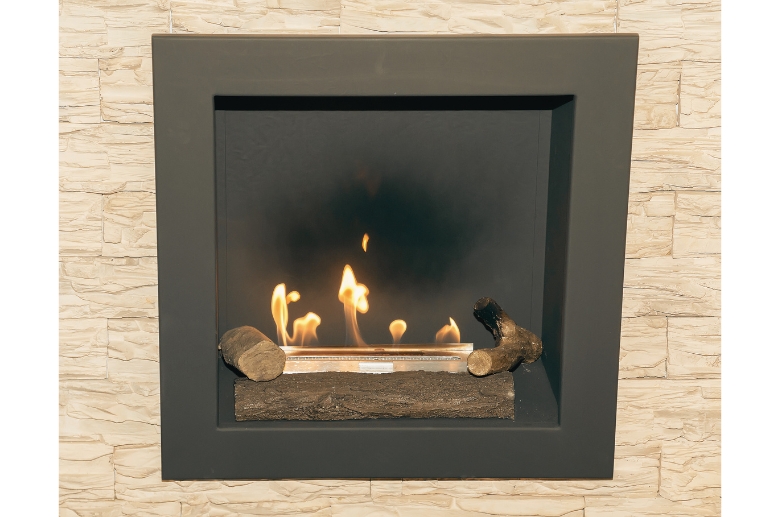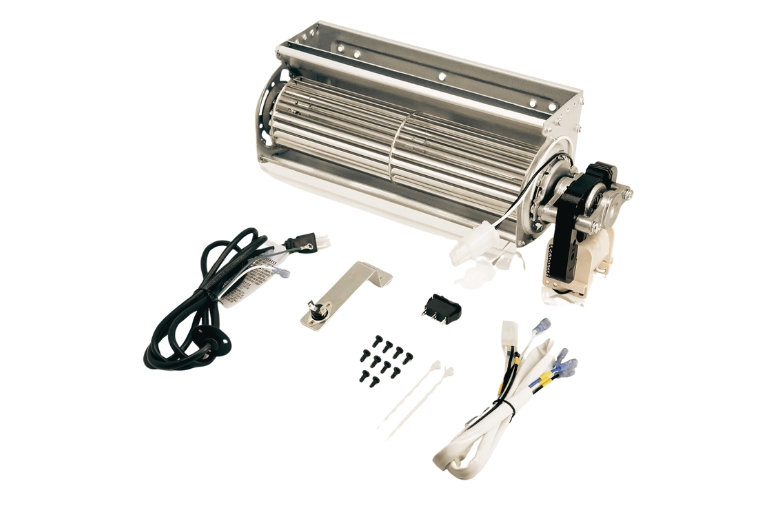When it comes to enhancing the warmth and coziness of your living space, choosing between a gas fireplace blower vs no blower can be a heated dilemma – pun intended.
This decision holds the key to maximizing heating efficiency and ensuring your comfort during chilly evenings. In this comprehensive guide, we’ll explore gas fireplaces and dissect the differences between blowers and no blowers.
We are here to assist you in making an informed decision that is tailored to your specific needs. Let’s get started, shall we?
How Gas Fireplaces with Blowers Work

Gas fireplaces with blowers leverage technology to enhance heat distribution and transform your living space into a cozy oasis. As part of understanding gas fireplace types, it’s important to recognize that those equipped with blowers are particularly efficient in circulating warm air throughout a room.
This feature sets them apart in functionality and efficiency from other types of gas fireplaces, offering a unique advantage in home heating.
Here are the mechanics behind it.
——
Do You Need to Hire Chimney & Fireplace Expert?
Get free quotes from qualified experts near you. No commitment required!
——
The Basics
At the heart of a gas fireplace blower’s functionality is its ability to circulate air efficiently. The blower, strategically positioned within the fireplace unit, works to propel warm air into the room. This process not only enhances comfort but significantly contributes to the overall gas fireplace efficiency, as it ensures that the warmth generated is not wasted but rather spread evenly across the living area.
This circulation is measured in cubic feet per minute (CFM), typically ranging from 75 to 250 CFM, ensuring a steady and even distribution of heat throughout the space.
Understanding this aspect of gas fireplace operation helps homeowners appreciate the balance between energy consumption and heating performance, allowing them to make an informed choice about their heating solutions.
Components in Action
The key components that make this magic happen include a fan or blower motor, an air intake, and an air outlet. As the gas logs ignite, generating warmth, the blower motor kicks into gear, drawing in cool air from the surroundings.
This air is then heated by passing over the hot surfaces within the fireplace, transforming it into a comforting warmth. The now-toasty air is propelled back into the room through the air outlet, creating a consistent and cozy ambiance.
Special Considerations
To optimize the performance of a gas fireplace blower, it’s essential to consider factors like variable speed settings. Some models allow you to adjust the blower speed, providing flexibility based on your heating needs and personal preferences.
Additionally, noise levels can vary among different brands and models, so it’s worthwhile to explore options that prioritize quiet operation if tranquility is a priority in your living space.
Common Brands Leading the Way
Several reputable brands have made a mark in the gas fireplace blower domain. Names like Heatilator, Napoleon, and Majestic are renowned for producing high-quality units with efficient blowers.
These brands often incorporate advanced technologies to ensure not only effective heat distribution but also energy efficiency, adding value to your home heating experience.
Pros and Cons of Gas Fireplaces with Blowers
Here are some of the pros and cons of using gas fireplaces with blowers.

Pros:
- Improved Heating Efficiency: Blower fans circulate warm air throughout the room, maximizing the fireplace’s heat output and reducing the amount of heat lost to the surrounding walls. This convective heat, in addition to the radiant heat directly from the flames, warms the room more effectively and evenly.
- Quick and Even Heating: Unlike purely radiant fireplaces, blowers quickly heat the space, providing immediate warmth and eliminating hot spots. This is especially beneficial for larger rooms or rooms with high ceilings, where radiant heat might struggle to reach all corners.
- Energy Efficiency: Gas fireplaces with blowers can be more efficient, resulting in lower fuel consumption and heating costs.
Cons:
- Noise: Blower fans can generate consistent humming or whirring sound noise, especially in higher settings. This can disrupt the peaceful ambiance of a crackling fire and might be a concern for noise-sensitive individuals.
- Electricity Dependence: Blower-equipped fireplaces require electricity to operate. Therefore, they won’t provide extra heat during power outages. This can be a disadvantage for those living in areas prone to blackouts.
How Gas Fireplaces Without Blowers Work

Let’s explore how no-blower gas fireplaces create a warm and inviting atmosphere.
Overview of Heating Mechanisms
Unlike their blower-equipped counterparts, gas fireplaces without blowers primarily rely on radiant heat. This type of heat is emitted directly from the fireplace, providing a cozy warmth that can be felt immediately.
The heat radiates from the flames and is absorbed by nearby surfaces, including the glass front of the fireplace, creating a comfortable environment without the need for forced air circulation.
Specific Models and Brands
Several reputable brands specialize in gas fireplaces without blowers, offering designs that focus on simplicity and a traditional fireplace experience. Brands such as Mendota, Empire Comfort Systems, and Ortal are known for their non-blower models.
These units prioritize the natural ambiance created by the flames without the additional circulation of air, making them ideal for those who appreciate a quieter and more straightforward heating solution.
Pros and Cons of Gas Fireplaces without Blowers
Like their counterparts, gas fireplaces without blowers also exhibit advantages and disadvantages, as discussed below.
Pros:
- Simplicity and Low Maintenance: Fireplaces without blowers require less maintenance and have fewer breakdowns due to fewer moving parts and a simpler design. Additionally, the absence of fans eliminates the need to worry about noise buildup or replacing worn-out components.
- Aesthetic Appeal: Unimpeded by fans or grilles, the flames in a blowerless fireplace take center stage. This unobstructed view allows you to fully appreciate the flickering dance of firelight, a key element for many homeowners who prioritize the visual beauty of a fireplace.
- Potential Energy Savings: While not guaranteed, blowerless fireplaces might be a more energy-efficient option in certain situations. In smaller spaces or rooms with good heat retention, radiant heat from the fireplace may be sufficient to maintain comfortable temperatures. This benefit depends on factors like fireplace size, room size, insulation levels, and climate.
Cons:
- Limited Heating Range: Unlike blower models that actively circulate warm air, radiant fireplaces primarily heat objects in their direct line of sight. This means corners and areas further away from the fireplace might feel colder, making them less effective for large open spaces or rooms with poor insulation.
- Slower Warm-Up Time: Radiant heat takes time to warm the surrounding environment compared to forced air from blowers. This can be a slight drawback if you’re looking for immediate warmth upon turning on the fireplace. However, the gentle, gradual heat of radiant fireplaces can be seen as a positive for those who prefer a more natural and comfortable ambiance.
——
Do You Need to Hire Chimney & Fireplace Expert?
Get free quotes from qualified experts near you. No commitment required!
——
Gas Fireplace Blower Vs No Blower Comparison
Gas fireplace blower vs no blower: Here’s how the two options compare head-to-head.
Heating Efficiency and Distribution
Gas fireplaces with blowers actively circulate warm air, quickly raising the temperature and ensuring even distribution throughout the room. This makes them ideal for large, open spaces where radiant heat from the fireplace alone might struggle to reach.
However, radiant heat from gas fireplaces without blowers warms objects in their direct line of sight, creating a more natural and localized warmth. While this might not be ideal for large spaces, it can be sufficient for smaller, well-insulated rooms, like bedrooms or cozy studies.
Energy Consumption
Using a blower fan for heating might be tempting, but it increases energy consumption as compared to non-blower models. However, if you are using the fireplace as your primary heating source, the blower fan’s efficiency benefits might outweigh the increased consumption.
Additionally, radiant heat relies solely on the fire’s warmth, translating to lower energy costs in scenarios where it provides sufficient heating. However, consider potential fuel inefficiency in larger rooms where radiant heat struggles to reach all corners.
Noise Levels
The whirring of the fan from a blower-equipped fireplace can disrupt the peaceful ambiance of a crackling fire, especially in higher settings. If serenity is your priority, blower noise might be a deal-breaker.
On the other hand, gas fireplaces without blowers are free from any mechanical noise. They’re perfect for those who seek a truly peaceful fireside experience.
Power Dependency
Electricity is the lifeblood of the blower, rendering the fireplace useless during power outages. Consider this drawback if reliable heat during blackouts is crucial.
Radiant fireplaces, on the other hand, provide reliable warmth without electricity, ensuring peace of mind in unpredictable weather situations.
Maintenance and Lifespan

Moving parts in a blower-equipped gas fireplace requires occasional maintenance, including cleaning and potential fan replacements. Also, blower systems tend to have a shorter lifespan of between 8-10 years with optimal maintenance.
Gas fireplaces with no blowers require minimal maintenance and have a potentially longer lifespan of 15 years or more, allowing for more time to enjoy the fire.
Cost and Installation
Let’s dissect the initial and long-term costs of each, helping you choose the option that warms your space and your budget.
Upfront Costs:
- Blower: Expect to pay $1,500-$3,000 for the unit itself, with another $300-$500 for installation. Adding a blower to an existing fireplace can cost $500-$1,500, depending on compatibility and complexity.
- No Blower: These start slightly lower, at $1,000-$2,500, with installation running the same $300-$500. But beware – retrofitting older fireplaces for a blower later could raise the total cost substantially.
Long-Term Savings:
- Blower: They shine in fuel efficiency, potentially saving up to 25% through their heat circulation magic. This translates to savings of $500 – $1,000 in energy costs annually, depending on usage and fuel costs. Over the fireplace’s life (10-20 years), these savings can easily outweigh the initial higher cost. Additionally, blowers can extend component lifespan by preventing overheating and lowering repair costs.
- No Blower: Their main charm lies in low upfront costs and minimal maintenance. But be prepared for potentially higher fuel bills, about $1,000+ annually, especially in large spaces or with frequent use. They also lack the blower’s efficiency and component protection benefits.
| Features | Blower | No Blower |
| Heating Efficiency | Faster and even warming, ideal for large spaces | More localized warmth, suitable for small spaces |
| Energy Consumption | Higher but may offset the cost difference if it’s the primary heating source | Lower |
| Noise Levels | Noticeable fan noise | Silent |
| Power Dependency | Yes, not useful during outages | No, reliable heat in any situation |
| Maintenance | Regular cleaning, potential fan replacements, shorter lifespan (10-20 years) | Minimal, longer lifespan (20+ years) |
| Cost (Upfront) | $1,500-$5,000+ for the unit and installation | $1,000-$3,000 for the unit and installation |
| Cost (Long-term | Lower if used heavily or in large spaces | Higher if used heavily or in large spaces |
——
Do You Need to Hire Chimney & Fireplace Expert?
Get free quotes from qualified experts near you. No commitment required!
——
Choosing the Right One Depending on Your Needs
The decision between a gas fireplace blower vs no blower involves factors like room size, blower operation, personal preference, and lifestyle. Let’s explore these considerations to guide you towards the ideal choice.
Room Size and Layout
Large spaces, especially those with high ceilings, benefit greatly from blowers due to their efficient heat circulation. Think open floor plans, cathedral ceilings, etc.
Smaller, well-insulated rooms might get sufficient warmth from radiant heat alone, making blowers less essential. Studios, bedrooms, or cozy nooks fall into this category.
Blower Operation
Consider whether immediate warmth is important. Some blowers only activate after the fireplace reaches a certain temperature, so a fireplace might have a blower, even if it’s not immediately apparent.
Personal Preference and Lifestyle
In the end, whether to install a blower or not largely depends on individual choices, way of life, and specific requirements. You may prefer the peaceful atmosphere of a fireplace without the sound of a blower, while others prioritize the effectiveness and even distribution of heat that a blower provides.
The Winner
In choosing between a gas fireplace blower vs no blower, the decision depends on the factors discussed above. Here’s a summary to ensure you’re well-informed:
Blower takes the crown in these scenarios:
- Large, open spaces: Spread the warmth throughout the room efficiently.
- Frequent fireplace use: Maximize fuel savings with efficient heat distribution.
- Need for fast warmth: Enjoy immediate heat as the blower circulates it quickly.
- Energy-conscious lifestyle: Consider long-term fuel savings, potentially outweighing the higher initial cost.
No blower shines in these situations:
- Cozy corners and small rooms: Radiant heat provides sufficient warmth in smaller spaces.
- Peaceful ambiance: Embrace the tranquil crackle of flames without fan noise.
- Lower upfront cost: Start enjoying your fireplace sooner with a budget-friendly option.
- Power outage preparedness: Enjoy reliable warmth even when the lights go out.
The winning choice? It’s personal! Carefully consider your room size, usage patterns, budget, and love for the fire’s gentle glow. Weigh the pros and cons, and let your needs guide you.






